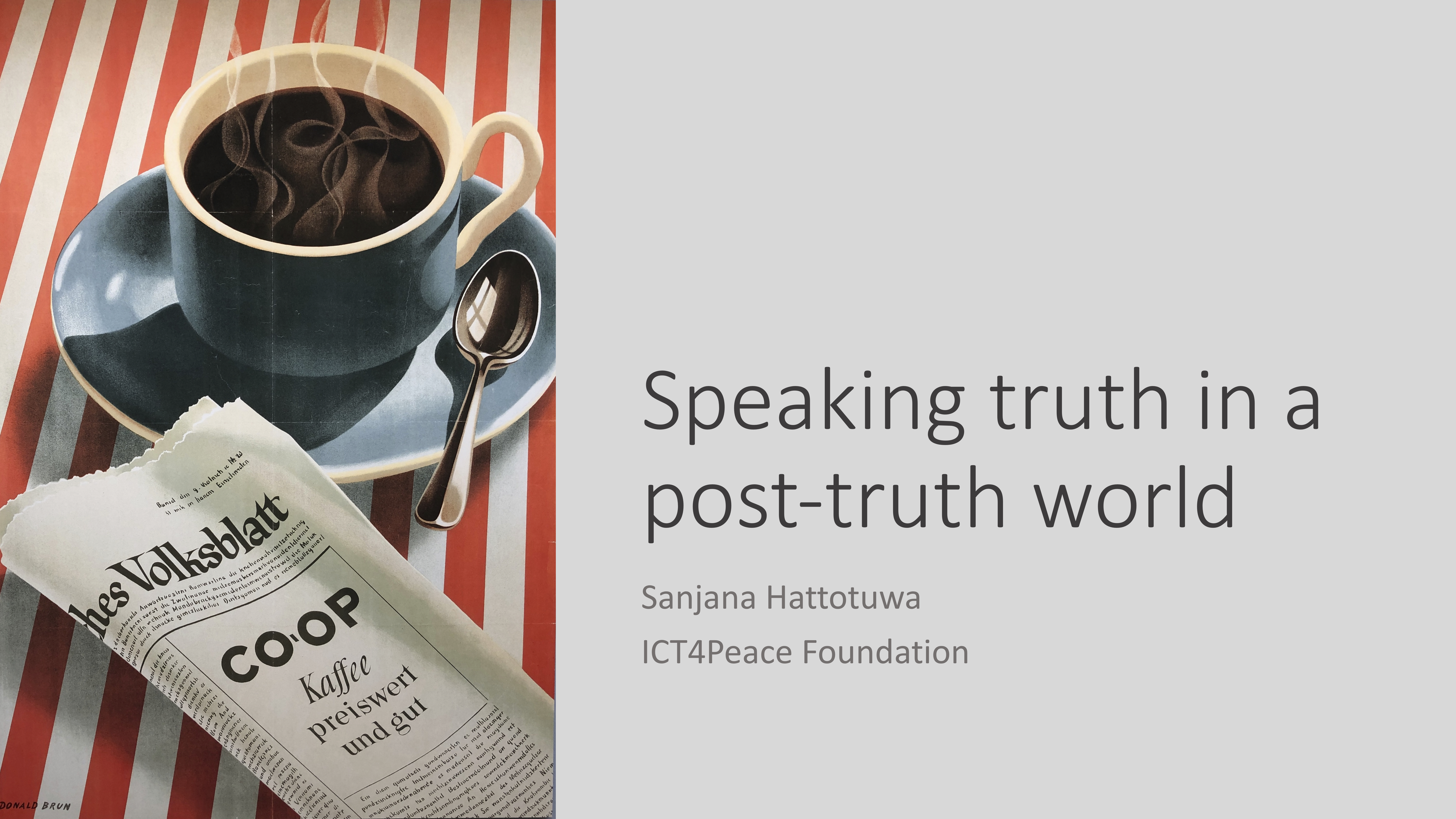As part of the #SpeakingTheTruth series of films supported by the ICT4Peace Foundation and the Zurich Hub for Ethics and Technology (ZHET) at the 2019 Zurich Film Festival, Sanjana Hattotuwa delivered a public presentation titled ‘Speaking truth in a post-truth world’ on 5 October. As noted on the ZFF website,
The murder of journalists, fake news, political agitation and economic pressure: there is no doubt that journalism is currently facing immense challenges. The free media plays an eminently important role in every democracy. Who will control government bodies and corporations if the so-called Fourth Estate loses its power? Do we live in a post-factual world where lies triumph over truth? How important to us is press freedom and investigative journalism? The ZFF’s #SpeakingTheTruth sidebar keeps abreast of this fascinating debate by presenting eight feature and documentary films that shine a light on those courageous people who use journalistic means and a great deal of commitment to search for the truth.
Sanjana’s presentation can be downloaded as a PDF here.
In his presentation, Sanjana began by framing how the projection, promotion and production of propaganda was not new to those of his generation, and older, in Sri Lanka. Post-truth politics and media, in this sense, wasn’t the result of social media. In flagging the landscape of disinformation and misinformation on social media, Sanjana highlighted key developments and trends that radically transformed the reach and relevance of the print or broadcast models of propaganda. Paying homage to the venue and the larger event of which Sanjana’s presentation was part of, the significant advances in computer-generated models and rendering techniques for mainstream Hollywood productions – from the de-aging of De Niro (in The Irishman) to a young Will Smith (in Gemini Man) – were flagged as technologies that in a few years would, once democratised into the palms of millions through apps, contribute to the generation of entirely false faces, characters and entire video sequences indistinguishable from truth or fact. Sanjana then went on to showcase marketplaces that already exist for the use and dissemination of faces generated by Artificial Intelligence (AI).
Sanjana then flagged several other key developments, including,
- The flipside of anonymity online, leading to increased trolling and toxic content generation
- The incomprehensibility of end-user license agreements, leading to the use of apps and services without any real understanding of privacy implications
- The systemic manipulation of social media, at scale, through algorithms as well as concerted efforts of disinformation growing in frequency, sophistication and scale
- The flipside of the privacy pivot of Facebook, leading to content creation over instant messaging apps that could increasingly contribute to violence
- The prevalence of dark signatures and dark patterns, influencing user behaviour online, in turn leading to practices that undermined end-user agency and privacy
- The counter-intuitive phenomenon where the greater use and prevalence of social media led to greater social division and divides, as well as the prospect of a weaker democracy
- Filter bubbles, where who one followed and what one believed in was strengthened as a consequence of the social media one consumed daily
- The beguiling nature of social media, compared to classical Greek mythology and the celebrated work of the Swiss-German painter Paul Klee
Sanjana then pivoted to what can be done, in this landscape, to bear witness. He called for the need to more carefully study the effects of social media, including by grounded research that was country, community, context-specific. Sanjana also called for the radical overhaul of Silicon Valley’s profit and business models, as well as greater oversight and regulation. The pivot to platform, content and conversational health over profit and growth, he noted, were already key initiatives of the largest social media companies, in just the past year. Platform toxicity wasn’t a problem they could ignore anymore. Agility, adoption & adaptation Sanjana noted were key elements in the use of social media around advocacy and activism, flagging the work in Sri Lanka (as well as Myanmar, Afghanistan, the Balkans, South Thailand, the Maldives, Egpyt and elsewhere) from 2006 on this score using Facebook, Twitter and a range of other social media platforms to strengthen rights and democracy. Highlighting celebrated author Chimamanda Ngozi’s prescient warning of the single-story, Sanjana noted that on social media the single story was, dangerously, often not seen as such. This creates the imperative, he averred, to create stories by those at the margins, for those at the margins, to escape being marginalised.
Quoting lines from Allen Ginsburg, Sanjana ended the presentation by noting that as much of the media reportage focussed on the negative effects, harms and toxicity of social media, so much of love, and peace, was also to be found on it – which is why, writ large, social media remains a potent tool in the hands of peacebuilding.
A video of the presentation will be made available here in due course.

